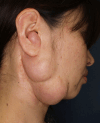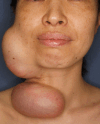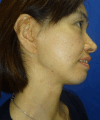A Novel Surgical Option Using Tissue Expanders for Intraparotid Facial Nerve Schwannoma
- PMID: 40672786
- PMCID: PMC12266899
- DOI: 10.1097/GOX.0000000000006978
A Novel Surgical Option Using Tissue Expanders for Intraparotid Facial Nerve Schwannoma
Abstract
Intraparotid facial nerve schwannomas (IFNSs) are slow-growing benign tumors. Their management is challenging due to their rare presentation. There are few reports on treatment strategies for IFNSs that have recurred after surgery; thus, the management of recurrent or regrown IFNSs is not standardized. We report a case of a regrown IFNS in a 38-year-old woman who had undergone subtotal resections twice and who developed moderate paralysis in the right mandibular branch of the facial nerve after the second surgery. Preoperative biopsy revealed infiltration of the tumor into the dermis, although there was no sign of malignant transformation. Thus, we performed a 2-stage surgery: in the first operation, we inserted tissue expanders, and in the second operation, we performed a subtotal resection of the tumor and resection of the overlying skin. After the operations, no facial nerve palsy was observed, and an aesthetically favorable result was achieved with scars being minimally visible. No evidence of tumor recurrence was observed during the 12-year follow-up period. Our case suggests that subtotal resection combined with the use of a tissue expander may be a surgical option for regrown IFNS cases with normal to moderate facial nerve function.
Copyright © 2025 The Authors. Published by Wolters Kluwer Health, Inc. on behalf of The American Society of Plastic Surgeons.
Conflict of interest statement
The authors have no financial interest to declare in relation to the content of this article.
Figures




Similar articles
-
Does Augmenting Irradiated Autografts With Free Vascularized Fibula Graft in Patients With Bone Loss From a Malignant Tumor Achieve Union, Function, and Complication Rate Comparably to Patients Without Bone Loss and Augmentation When Reconstructing Intercalary Resections in the Lower Extremity?Clin Orthop Relat Res. 2025 Jun 26;483(9):1680-95. doi: 10.1097/CORR.0000000000003599. Online ahead of print. Clin Orthop Relat Res. 2025. PMID: 40569278
-
Treatment options for progression or recurrence of glioblastoma: a network meta-analysis.Cochrane Database Syst Rev. 2021 May 4;5(1):CD013579. doi: 10.1002/14651858.CD013579.pub2. Cochrane Database Syst Rev. 2021. PMID: 34559423 Free PMC article.
-
Immunomodulators and immunosuppressants for multiple sclerosis: a network meta-analysis.Cochrane Database Syst Rev. 2013 Jun 6;2013(6):CD008933. doi: 10.1002/14651858.CD008933.pub2. Cochrane Database Syst Rev. 2013. PMID: 23744561 Free PMC article.
-
Rehabilitation for ankle fractures in adults.Cochrane Database Syst Rev. 2024 Sep 23;9(9):CD005595. doi: 10.1002/14651858.CD005595.pub4. Cochrane Database Syst Rev. 2024. PMID: 39312389
-
What Are the Complications, Function, and Survival of Tumor-devitalized Autografts Used in Patients With Limb-sparing Surgery for Bone and Soft Tissue Tumors? A Japanese Musculoskeletal Oncology Group Multi-institutional Study.Clin Orthop Relat Res. 2023 Nov 1;481(11):2110-2124. doi: 10.1097/CORR.0000000000002720. Epub 2023 Jun 14. Clin Orthop Relat Res. 2023. PMID: 37314384 Free PMC article.
References
-
- Hato N, Fujiwara T, Gyo K, et al. Yanagihara facial nerve grading system as a prognostic tool in Bell’s palsy. Otol Neurotol. 2014;35:1669–1672. - PubMed
-
- Alicandri-Ciufelli M, Marchioni D, Mattioli F, et al. Critical literature review on the management of intraparotid facial nerve schwannoma and proposed decision-making algorithm. Eur Arch Otorhinol. 2009;266:475–479. - PubMed
-
- Kreeft A, Schellekens PPA, Leverstein H. Intraparotid facial nerve schwannoma. What to do? Clin Otolaryngol. 2007;32:125–129. - PubMed
-
- Gross BC, Carlson ML, Moore EJ, et al. The intraparotid facial nerve schwannoma: a diagnostic and management conundrum. Am J Otolaryngol. 2012;33:497–504. - PubMed
-
- Mcmonagle B, Al-Sanosi A, Croxson G, et al. Facial schwannoma: results of a large case series and review. J Laryngol Otol. 2008;122:1139–1150. - PubMed
Publication types
LinkOut - more resources
Full Text Sources
